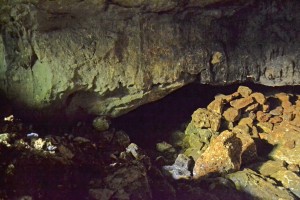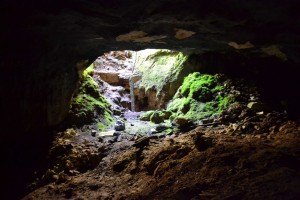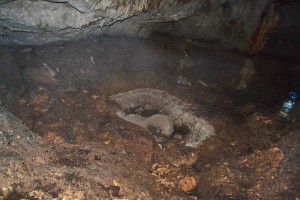This is an odd site. It is essentially a Byzantine arch built over a deep, living cave. It’s easy to take a wrong turn finding it. A massive wind farm is taking shape in the area and the many access roads to the turbines aren’t yet (July 2016) on Google Earth or the mapping apps that I use to find my way around. In the end, I found it because I stopped to catch the biggest Slow Worm (Anguis fragilis) I have ever seen as it slithered off into some recognisable landmarks.
The monastery itself is in the middle of a field (41.620874905856, 27.829430757638). In a big clump of brambles, nettles and plants with spiky seeds, a rather neat Roman arch may be discerned. It’s probably less scratchy to go there in winter. One swings oneself down the hole beneath the vault and, after a brief period of being out of control, finds oneself on a flattish stony area that may once have been a flagged floor.

Back entrance
Once inside, it becomes clear that one must go downwards into pitch blackness to make any progress. There is a big pile of reddish rock in the centre. It may be that this has been dug out by treasure hunters, which would account for the craggy nature of the floor of the cave below it.
At this point, it becomes clear that this is a very active limestone cave. The ceiling drips and there is that unmistakable lime smell of living caves. The ceiling is wet and slippery with tiny spikes and shawls developing. It’s either newly active or the religious users of the cave used to clean the precipitation features off. One can see their point – nothing interferes with monastic dignity more than bumping one’s head on a lengthening stalactite. In any case, there are no spectacular columns or helictites. There is a pool, constantly added to by drips from the roof. This may have been the ayazma (sacred spring) of the monastery.
The Kırklareli Envanteri site reports confidently that the cave forms a monastery of about 20m x 10m, aligned on an east-west axis. I didn’t see anything as clear-cut as that. This may be because my torches were bad and my camera had difficulty focusing. Still, it is hard to see any evidence that this was a monastery. Perhaps the cave was the ayazma for a previously existing monastery. However, I could find no evidence of other building activity, either in the literature or on site, so that is probably a poor conclusion. This source mentions an extensive necropolis closer to Küçükyayla village itself (about 2km away) but nothing closer.
Beksaç, E. (2012) Kuzeybatı Anadolu ve Trakya’da erken kültistik kaya (kaya oyma ve megalit) anıtları ve kült alanları projesi Edirne Kırklareli yüzey arıştırması 2010 Çalışmaları. In Özme (ed) 29. Arıştırma Sonuçları Toplantısı 3. Cilt. T.C.Kültür ve Turizm Bakanlığı, Kültür Varlıkları ve Müzeler Genel Müdürlüğü. Pages 1 – 12 Available online at http://www.kulturvarliklari.gov.tr/Eklenti/4650,29arastirma3.pdf?0 Accessed 25th July 2016
Civelek, E. (2016) Küçükyayla Mağra Manastırı. Kırklareli Kültür Varlıkları Envanteri. available online at: http://www.kirklarelienvanteri.gov.tr/anitlar.php?id=82 Accessed 25th July, 2016

Categories: Uncategorized | No Comments »









